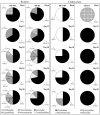Viability of zooplankton resting eggs in rice field sediment after pesticide applications
- PMID: 37614560
- PMCID: PMC10442695
- DOI: 10.3897/BDJ.11.e106418
Viability of zooplankton resting eggs in rice field sediment after pesticide applications
Abstract
Many herbicide products are commonly used in agricultural areas to prevent and eliminate weeds. Contamination from these toxicants in water might affect aquatic organisms not only in the active stage, but also in the diapause stage. To test the effect of herbicide on the resting eggs of zooplankton, we prepared two rice fields: one field without the application of pesticides (RF-NPA) and one with the application of pesticides (RF-PA) in a sampling year. We conducted a hatching experiment for 30 days. Twenty-four taxa of zooplankton were found. Sixteen species of these were rotifers, seven species were cladocerans and one taxon was an unidentified nauplius copepod. The species richness of zooplankton between RF-NPA (17 taxa) and RF-PA (16 taxa) was close, but species compositions between RF-NPA and RF-PA were different, indicated by the similarity index of 0.545. Lecanidae was the most diverse family of rotifers in both rice fields with nine species, while Chydoridae was the most diverse family of cladocerans (four species). The total abundance of zooplankton of RF-NPA was higher than RF-PA with 1,897 and 1,286 individuals, respectively. The Shannon-Wiener diversity index (H´) and Pielou's evenness (J) in RF-NPA were higher than in RF-PA. The high species richness of zooplankton in both rice fields occurred on days 18 to 30. On the other hand, the highest abundance was recorded on day 18 for RF-NPA and on day 24 for RF-PA. The non-metric multidimensional scaling (NMDS) demonstrated significant differences in zooplankton community composition between RF-NPA and RF-PA (p < 0.05; ANOSIM test). According to the diversity indices, the RF-NPA has more diversity than the RF-PA, which might be a result of herbicide application in the sampling year. This study suggests that the toxicity of glyphosate should be a concern in terms of the biodiversity of rice field ecosystems.
Keywords: biodiversity; glyphosate; resting egg; temporary habitat.
Nattaporn Plangklang, Sujeephon Athibai.
Conflict of interest statement
No conflict of interest to declare Disclaimer: This article is (co-)authored by any of the Editors-in-Chief, Managing Editors or their deputies in this journal.
Figures








Similar articles
-
Disruption of the hatching dynamics of zooplankton egg banks due to glyphosate application.Chemosphere. 2017 Mar;171:644-653. doi: 10.1016/j.chemosphere.2016.12.110. Epub 2016 Dec 26. Chemosphere. 2017. PMID: 28056451
-
Widespread agrochemicals differentially affect zooplankton biomass and community structure.Ecol Appl. 2021 Oct;31(7):e02423. doi: 10.1002/eap.2423. Epub 2021 Aug 17. Ecol Appl. 2021. PMID: 34288209
-
A long-term study on zooplankton in two contrasting cascade reservoirs (Iguaçu River, Brazil): effects of inter-annual, seasonal, and environmental factors.PeerJ. 2020 May 5;8:e8979. doi: 10.7717/peerj.8979. eCollection 2020. PeerJ. 2020. PMID: 32411516 Free PMC article.
-
Effects of pollution on dormant-stage banks of cladocerans and rotifers in a large tropical reservoir.Environ Sci Pollut Res Int. 2021 Jun;28(24):30887-30897. doi: 10.1007/s11356-021-12751-x. Epub 2021 Feb 16. Environ Sci Pollut Res Int. 2021. PMID: 33594550
-
Herbicide resistance and biodiversity: agronomic and environmental aspects of genetically modified herbicide-resistant plants.Environ Sci Eur. 2017;29(1):5. doi: 10.1186/s12302-016-0100-y. Epub 2017 Jan 21. Environ Sci Eur. 2017. PMID: 28163993 Free PMC article. Review.
References
-
- Abdullah A R;, Bajet C M;, Matin M A;, Nhan D D;, Sulaiman A H. Ecotoxicology of pesticides in the tropical paddy field ecosystem. Environmental Toxicology and Chemistry. 1997;16(1):59–70. doi: 10.1002/etc.5620160106. - DOI
-
- Araújo L. R., Lopes P. M., Santangelo J. M., Petry A. C., Bozelli R. L. Zooplankton resting egg banks in permanent and temporary tropical aquatic systems. Acta Limnologica Brasiliensia. 2013;25(3):235–245. doi: 10.1590/S2179-975X2013000300004. - DOI
-
- Battauz Y. S., de Paggi S. B.J., Paggi J. C. Passive zooplankton community in dry littoral sediment: Reservoir of diversity and a potential source of dispersal in a subtropical floodplain lake of the Middle Paraná River (Santa Fe, Argentina) International Review of Hydrobiology. 2014;99(3):277–286. doi: 10.1002/iroh.201301670. - DOI
-
- Brendonck L;, De Meester L. Egg banks in freshwater zooplankton: Evolutionary and ecological archives in the sediment. Hydrobiologia. 2003;491:65–84. doi: 10.1023/A:1024454905119. - DOI
LinkOut - more resources
Full Text Sources
